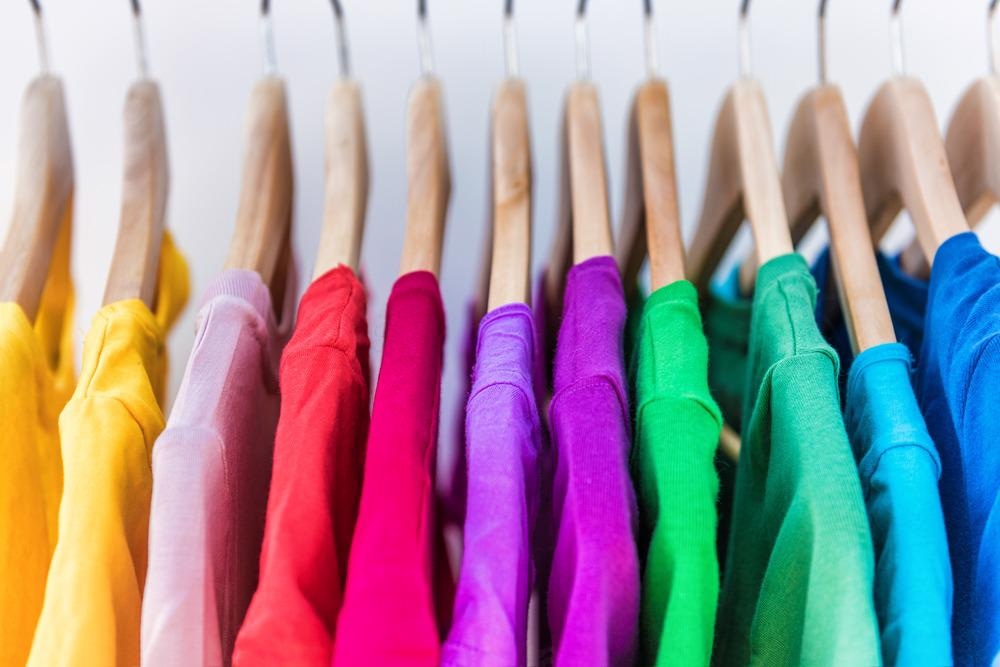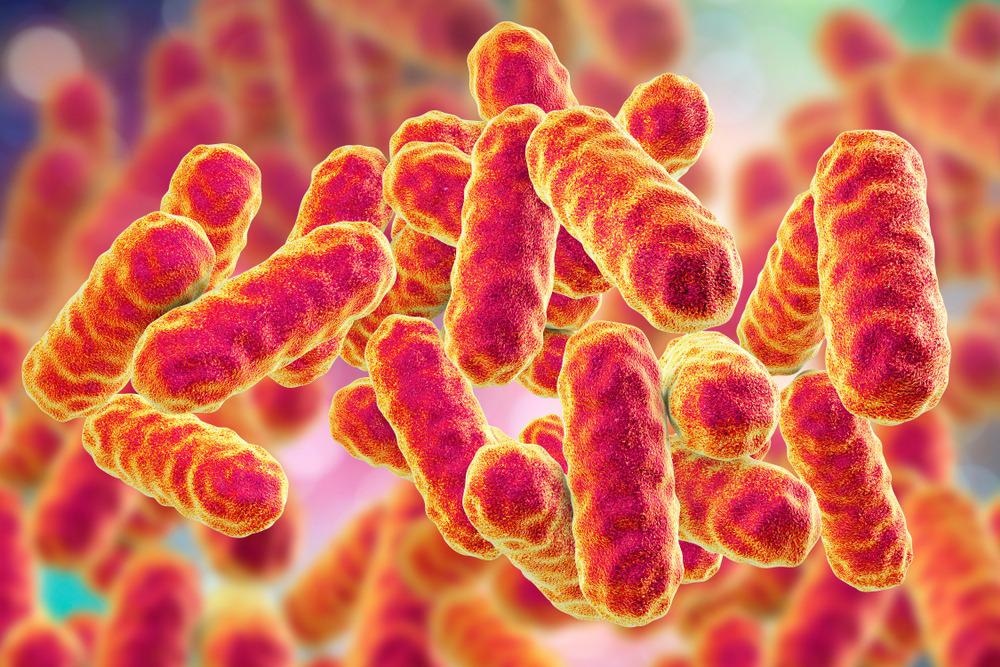Exploring alternative dyes in the textile industry is prompted by environmental pollution and high cost. Twenty percent of wastewater is generated by the textile industry. Many dyes are synthesized from non-renewable sources such as fossil fuels. They are often toxic to human health.

Image Credit: Maridav/Shutterstock.com
Microorganisms can produce a wide array of pigments such as riboflavin, prodigiosin, violacein(s), canthaxanthin, astaxanthin, and carotenoids. Micro-organisms can be subject to genetic modifications to optimize pigment production and minimize health concerns. They are also very scalable. Many bacterial pigments also possess intrinsic anti-microbial activity, highlighting their potential use in wound care.
Factors that regulate pigment production
There are a wide number of factors that can affect pigment production in bacteria. Temperature is a major factor. Different species require different optimal temperatures to produce pigments such as 25-28°C (Monascus) or 35-36°C (Pseudomonas). pH is important, especially in the production of carotenoids: different pHs can shunt metabolism in favor of one or another.
Other factors include a carbon source, mineral concentration, type of fermentation, aeration, and moisture content. It is often necessary to modulate factors when using a host cell for production.
Indigo
Indigo is one of the most ubiquitous pigments in the textile industry. Indigo is currently synthesized from aniline, a fossil fuel-derived feedstock. The advent of bioinformatics has allowed for the discovery of many species capable of producing indigo. These species use specific enzymes to catalyze indole into indigo using an oxygenation process.
Issues surrounding yield, multi-gene expression, and genetic engineering limit its efficacy. Bacterial flavin-containing monooxygenases showed the greatest success: 1g/L of indigo was produced in a fermented process using Escherichia coli as a recombinant host.
Violacein
Violacein is an indole-derived compound with a deep purple hue. It can be obtained from Chromobacterium violaceum and Janthinobacterium lividum. Many of its derivatives can produce colorants such as proviolacein (green), prodeoxyviolacein (blue), violacein (navy), and deoxyviolacein (purple). Researchers have been successful in generating high levels of violacein in host cells such as E. coli following genetic manipulation.
Bacterial violacein is difficult to extract and purify, prompting this genetic engineering. Violacein can dye jacquard rayon, pure rayon, and silk. It can dye fabric in the absence of chemical solvent, in a mildly fermented process, mitigating the environmental concerns of dyeing clothing.
Prodigiosin
Prodigiosins are a family of bright-red pigments derived from marine Serratia marcescens, Vibrio gazogenes, and some actinomycetes. Numerous factors such as strain, temperature, illumination, incubation time, and pH influence pigment production. Serratia marcescens has been shown to produce prodigiosin at sufficient levels to dye many fabrics including cotton, silk, and polyester.
Due to their inherent hydrophobicity, it is necessary to dissolve them in organic solvents. Methods are now being implemented to improve their solubility and subsequent dyeing including pH-mediated nano micelles. Extracts from strains of Streptomyces (NP2 and NP4) contained prodigiosin-like compounds that produced strong red and blue colorants, respectively, capable of dyeing synthetic fibers such as polyamide, acrylic, and (to a lesser extent) polyester. Retention and stability of the colorant in natural textiles remain ongoing issues.

Image Credit: Kateryna Kon/Shutterstock.com
Genetic engineering
Genetic engineering has been utilized to improve pigment production in the native species or more amenable host species e.g., E. coli. Radiation was used to generate mutant species of Serratia marcescens capable of producing much larger volumes of prodigiosin. Corynebacterium glutamicum was genetically engineered to produce greater levels of indigoidine (an indigo-like colorant). This was achieved by expressing the indigoidine synthetase enzyme from another species and then modulating the nutrient supply to enhance indigoidine production and limit by-product formation.
Genetic manipulation of the bacteria E. coli presents exciting new opportunities to produce large volumes of colorants across the color rainbow. E. coli has been used as a model organism in biotechnology due to its easy genetic engineering, rapid growth rate, and its amenable nature in recombinant protein technology. Improved understanding of gene expression and metabolism in other bacteria has facilitated the engineering of E. coli.
For example, the metabolic pathways of carotenoids can be manipulated to produce β-carotene, zeaxanthin, and astaxanthin. These display orange, yellow, and red, respectively. Another study investigated the production of violacein in host E. coli cells. The genes associated with tryptophan (a precursor) production were overexpressed. Genes that would shunt carbon flux away from it were then silenced.
The genes responsible for violacein production were then integrated into the host cell. This resulted in significantly higher volumes of pure violacein. This demonstrates that host cells like E. coli function as excellent conduits for exogenous pigment production.
A study undertaken by Lee et al utilized metabolically engineered E. coli cell lines to produce appreciable levels of the above colorants. Further manipulation of factors that regulated vesicular trafficking served to enhance production. This engineering enhanced production but not secretion. This will prompt further investigation into the downstream processing necessary to extract and purify the colorants.
Conclusion
Bacterial pigments present excellent alternatives to synthetic dyes currently used in the textile industry. They are scalable, are easily manipulated to optimize yield, are renewable, and present fewer health concerns. Many hurdles must be overcome before they present an effective alternative, however. Improved understanding of the metabolic programming in the endogenous bacteria will be necessary to optimize the production of the pigments of interest.
Genetic engineering can be utilized to modify bacteria such as E. coli. It is important to consider the parameters that affect growth and scalability like temperature, aeration, and nutrient abundance. The physicochemical characteristics of the pigment may warrant further downstream processing; factors such as secretion, solubility, and toxicity all need to be considered.
Sources:
- Choi, S. Y. et al. (2015) ‘Violacein: Properties and Production of a Versatile Bacterial Pigment’, BioMed Research International. Edited by F. Marinelli, 2015, p. 465056. doi: 10.1155/2015/465056.
- Fabara, A. N. and Fraaije, M. W. (2020) ‘An overview of microbial indigo-forming enzymes’, Applied microbiology and biotechnology. 2019/12/13, 104(3), pp. 925–933. doi: 10.1007/s00253-019-10292-5.
- Ghiffary, M. R. et al. (2021) ‘High-Level Production of the Natural Blue Pigment Indigoidine from Metabolically Engineered Corynebacterium glutamicum for Sustainable Fabric Dyes’, ACS Sustainable Chemistry & Engineering, 9(19), pp. 6613–6622. doi: 10.1021/acssuschemeng.0c09341.
- Gong, J. et al. (2017) ‘pH-Mediated Antibacterial Dyeing of Cotton with Prodigiosins Nanomicelles Produced by Microbial Fermentation’, Polymers. doi: 10.3390/polym9100468.
- Kramar, A. et al. (2014) ‘Crude bacterial extracts of two new Streptomyces sp. isolates as bio-colorants for textile dyeing’, World Journal of Microbiology and Biotechnology, 30(8), pp. 2231–2240. doi: 10.1007/s11274-014-1644-x.
- Ryazantseva, I. and Andreyeva, I. (2014) “Application of prodigiosin as a colorant for polyolefines.” Advances in Biological Chemistry, 4, 20-25.
- Liu, X. et al. (2013) ‘MUTANT BREEDING OF Serratia marcescens STRAIN FOR ENHANCING PRODIGIOSIN PRODUCTION AND APPLICATION TO TEXTILES’, Preparative Biochemistry & Biotechnology, 43(3), pp. 271–284. doi: 10.1080/10826068.2012.721850.
- Yang, D., Park, S. Y. and Lee, S. Y. (2021) ‘Production of Rainbow Colorants by Metabolically Engineered Escherichia coli’, Advanced Science, 8(13), p. 2100743. doi: https://doi.org/10.1002/advs.202100743.